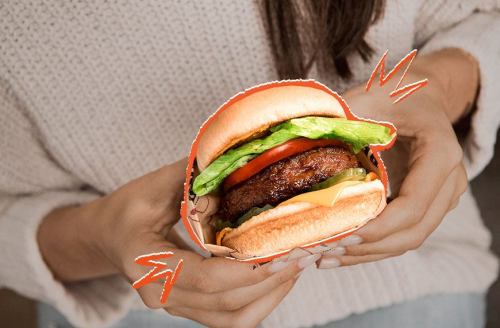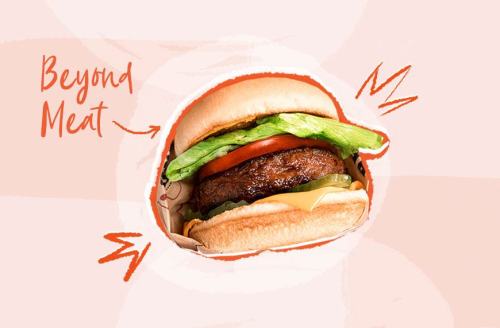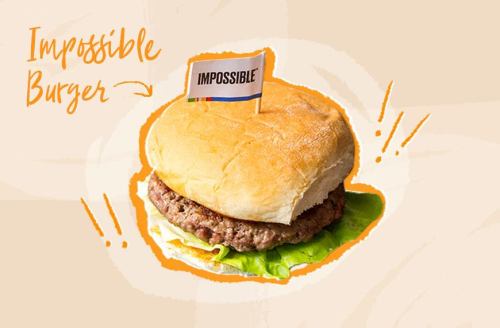We’re calling it: 2019 will be the year of even more “alt-meats”
Confused about Beyond Meat, Impossible Foods, and lab-grown meat brand JUST? Here's everything you need to know about trendy alternative meat products.

It’s 2019 and honestly, there’s never been a better time to cut back on meat. It wasn’t all that long ago (seriously it was like, four years ago) when your meatless options were…well, just veggie patties and fake meat hot dogs. Not very tempting, TBH.
Fortunately for vegans and vegetarians, the many alternative meat products now available no longer taste like cardboard—and the ingredients list doesn’t take up the whole back of the packaging. But the food industry has been so innovative in the sustainable meat and meat substitute departments that change is happening faster than consumers—and the Food and Drug Administration—can keep up with. Between vegan burgers that “bleed” just like real meat, to chicken breasts and beef patties grown in a lab from the cells of livestock, it’s complicated, and the lines between what’s truly meat and what isn’t are getting blurred.
Three brands in particular are innovating at lightning speed: Beyond Meat, Impossible Foods, and JUST. Consider this your comprehensive guide to the trendiest of alt-meats, breaking down everything that goes into bringing these products to life. Besides intel straight from the companies themselves, a food advocate and a registered dietitian also share their thoughts. Because like we said: It’s complicated.
Confused by all the new “meat” options out there? Here’s everything you need to know.

Beyond Meat
With a product line including plant-based burgers, sausage, chicken strips, and beef crumbles, Beyond Meat gets a lot of praise for tasting just like meat. The brand’s CEO, Ethan Brown, also insists that the products be sold in grocery stores right next to the “real” meat and not with the other vegan products. “It’s a really important step in terms of reframing how we think about meat,” he told Bloomberg. “We assume that an animal has to be used for meat, and that’s just false.”
But when it comes down to it, it’s really a vegan, meat substitute; they’ve just perfected a plant-based formula that tastes extremely similar to the real thing. “What we do is study meat’s structure, understanding what makes up the muscle tissue,” says Dariush Ajami, Beyond Meat’s chief innovation officer. He says there are four key elements to animal muscle—protein, fat, water, and glycogen—present in very specific proportions. “Then, we use plant sources to [mimic] that,” he says. With some key seasonings, of course.
The brand is about to launch a new iteration of their flagship Beyond Burger product. The official ingredients list hasn’t yet been revealed, but Ajami says it will be very similar to the burger they sell at Carls Jr., which gets its protein from pea protein isolate, rice protein, and mung bean protein. It also contains canola and coconut oils, water, methylcellulose (a thickening agent), potato starch, and various extracts and seasonings for flavor and color (like beet juice extract and pomegranate fruit powder).
Something you won’t see on the label: soy or gluten, which Ajami says the brand made a priority not to use in their products. Instead, their main protein hero is pea protein isolate—made from, but slightly different than, straight peas. “Dried yellow peas, which is what we use, are 15 to 20 percent protein. The rest of it is starch, fiber, and water,” says Ajami. “For us to get to 20 grams of protein per serving, we had to isolate the protein, taking away those other components.” This is done by drying the proteins and then using a machine that dissolves the starch and fiber into water, leaving behind the protein.
Pea protein isolate is in lots of other products besides Beyond Meat (such as in dairy-free ice creams). “Nothing we do is new and none of our ingredients are new,” Ajami says. But they way they combined and used the ingredients make the products truly…beyond, in fans’ eyes.
What a food advocate says: Dana Perls is a senior food and agriculture campaigner for Friends of the Earth, an environmental advocacy group. While she wishes Beyond Meat’s ingredients were organic, Perls says the patties aren’t made that differently from other vegan patties. “It doesn’t raise as many red flags as literal lab-grown meat,” she says.
What a registered dietitian says: Joan Salge Blake, EdD, RDN, LDN, a registered dietitian, Boston University associate professor, and nutrition textbook writer, doesn’t have a problem with anything on the Beyond Burger label except for one thing: the saturated fat. While the new product’s ingredient construction may change it a little, the Beyond Burger currently on the market has 5 grams of saturated fat, aka 25 percent of your daily value. “This is coming from all the coconut oil,” she says. “Americans are having too much saturated fat, which is linked to high cholesterol.” Other than that, Blake gives this meat substitute the OK to eat.

Impossible Foods
Impossible Foods is different from Beyond Meat primarily because of what the brand refers to as their “magic ingredient”: heme. “It’s one of our earliest and important discoveries—done by our founder Pat Brown—and is responsible for the unique flavors and cooking properties of the ‘meat,'” says Rachel Konrad, the chief communications officer at Impossible Foods.
Konrad says heme is an iron-rich molecule found in all living things (plants and animals alike). Basically, it gives the product its bloody taste. “It catalyzes reactions in your mouth that generate these very potent odor molecules that smell bloody and metallic,” Brown told Bloomberg. It’s also red, so it looks like blood, too.
But even though heme makes the Impossible Burger look like meat, it’s completely plant-based. “We figured out a way to take the heme that occurs naturally in plants, specifically soy plants, to give the Impossible Burger the unmistakable sensory experience of meat from animals—but without animals,” Konrad says. Their heme—specifically, soy leghemoglobin—is sourced from the root of soy plants.
Even though soy leghemoglobin is an unfamiliar ingredient to most people, Konrad rejects the term “lab-grown meat.” “Impossible Foods has a laboratory, but we don’t make meat inside our lab,” she says. “In general, when people use the term ‘lab meat,’ they mean ‘cultured meat,’ tissue grown in petri dishes from the cells of [animals]. That’s very different from plant-based meat, which we make from plants.” (We’ll get to true cultured meat in a second.)
As far as the other ingredients on the Impossible Burger label, the protein comes from a combination of textured wheat protein and potato protein. Water, coconut, and natural flavors make up the other primary ingredients. There are also small amounts—less than two percent—of soy leghemoglobin, yeast extract, salt, konjac gum, xanthan gum, soy protein isolate, vitamin E, vitamin C, thiamin (vitamin B1), zinc, niacin, vitamin B6, riboflavin (vitamin B2), vitamin B12.
What a food activist says: Perls has her concerns about Impossible Foods. “If you look at market trends, consumers have made it clear that they want whole food ingredients, not genetically grown proteins, which is what you’ll find in the Impossible Burger,” she says. “Safe meat alternatives for vegetarians already exist.”
Meanwhile, she says it’s not clear from her standpoint if the Impossible Burger is safe for people to eat. “The first application that Impossible Foods sent to the FDA came back with a number of concerns about allergens, the lack of longterm safety assessment, and questions about 46 undisclosed proteins that have never been in the human diet before,” Perls says. “We need real transparency and real food people can trust, and this takes us in the opposite direction.”
To her point, the Food and Drug Administration put Impossible Foods through the ringer, raising concerns about long-term consumption of heme and extending its safety review of the product. However, the FDA ultimately approved it, granting soy leghemoglobin “generally recognized as safe” status in 2018. At the end of July, Impossible Foods obtained the FDA’s approval to be sold in grocery stores starting September 3, 2019 (it’s currently only available at restaurants).
What an RD says: Blake is unfamiliar with heme since it’s such a new ingredient, but there was something else that raised her eyebrows: the saturated fat, which clocks in at 14 grams. “Here we go again with the coconut oil,” Blake says. “A lot of these plant-based burgers are getting a lot of press, but I would prefer for people to find an alternative with less saturated fat.” She didn’t have a problem with anything else on the label, including the soy, which she says is perfectly healthy in moderate amounts.

JUST
Unlike Beyond Meat and Impossible Foods, JUST’s alt-meat product isn’t vegetarian. The company—which currently has vegan egg and cookie dough products on the market—hopes to launch chicken bites made from the stem cells of animals soon. They also plan on expanding to beef and pork products in the future.
Vítor Espírito Santo, associate director of cellular agriculture at JUST, explains their process like this. He removes cells from live chicken, cows, or pigs and takes them to the lab. There, the cells are fed a solution of nutrients (the same ones any living thing needs to grow, though the brand would not specify what is in their blend) to make the cells reproduce. “As the cells grow and multiply, they will form a concentrate of animal cells that has the same texture, consistency and flavor of ground meat, and that is the final harvest that we use to produce our cultured meat products,” Santo says.
The cultured cells multiply into animal tissue, but they do not grow to the point of creating a fully-formed animal. “The process is actually very similar to what occurs in beer production, where yeast fermentation in brewery large tanks leads to the formulation of a delicious drink,” Santo says. Only here, they’re using animal cells instead of yeast.
“With the cell culture, everything we’re using is to mimic the physiological condition of the animal,” Santos says. “We want to make the cells feel that they’re still in the animal body.” Between five days and two weeks later, when enough animal tissue has been grown, he hands it off to VP of product development, Chris Jones, who perfects the flavor and texture profiles of the meat with a team of chefs.
So, why cultured meat instead of going the plant-based route? “It’s pretty obvious that folks all around the world enjoy eating meat,” co-founder and CEO Josh Tetrick says, adding that he can’t imagine his home state of Alabama ever going vegetarian. “The problem is, we use a massive amount of land just to feed these animals, and they’re also creating a lot of waste. It isn’t very sustainable.” So, he decided to find what he felt was a more ethical, environmentally friendly way to still eat real meat.
Tetrick also says it provides the option to provide better tasting meat, because the cells are cultured from more premium sources. “We’re working on a Waygu steak right now and are culturing the cells from these cows in Japan who are known to be the best tasting cows in the world,” he says.
As mentioned, JUST is launching with chicken, and their ingredients list and nutritional profile aren’t officially out yet. The brand released this statement to Well+Good: “This product primarily contains chicken cells, produced using animal cell culture technology, along with mung bean protein, a proprietary blend of spices, salt, sugar, and sustainably sourced canola oil.”
What a food advocate says: Despite this being a more sustainable alternative to factory farming, Perls isn’t convinced cultured meat is the way to go. “There are chemicals used to create that cell culture to make the lab-grown meat,” she says. “Each of those inputs must be assessed for safety. We can’t just focus on the final product.”
She emphasizes that consumers want more transparency, not less. “We have pasture-raised animals with high animal welfare standards that are a healthy and environmentally friendly option. So rather than looking to high-tech products that have not been in the human diet, we need to look at the truly sustainable solutions that we already have.”
Both FDA and the United States Agriculture Department are involved regulating all cell-cultured meat products. The two agencies are working closely with JUST and other companies in this space to ensure the safety of their products.
What a registered dietitian says: Because the nutritional panel isn’t out yet (and like to most of us, the concept of cultured meat is still new to her), Blake says she can’t form a definitive opinion on how healthy the JUST products are yet. She says the tentative ingredients list looks clean to her.
As more meat-like products enter the market, it’s more important than ever to be a conscious consumer. Don’t be afraid to ask questions, whether it’s to the brands, the agencies regulating our consumption, and nutrition experts. The more you know, the better food choices you can make for yourself—and that goes for whether you’re a carnivore or not.
This piece was originally published on February 1, 2019. It was updated on August 1, 2019.
While we’re tackling tricky food topics, here’s everything you need to know about GMOs. Plus, common food shopping mistakes even healthy eaters make.
Sign Up for Our Daily Newsletter
Get all the latest in wellness, trends, food, fitness, beauty, and more delivered right to your inbox.
Got it, you've been added to our email list.










